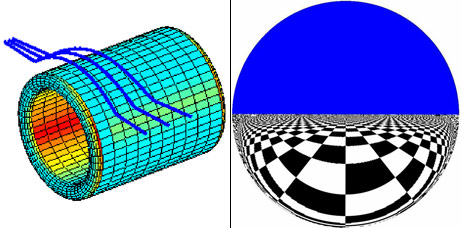|
Star Gate Facts Wormhole Technology |
|
|
..
"Electromagnetic
Wormhole" Could Make Objects Invisible
An "electromagnetic wormhole" could make objects traveling through it invisible, scientists say. A group of mathematicians, including Allan Greenleaf of the University of Rochester, recently thought up a way to build such a device. It would not be what is commonly known as a wormhole—a theoretical bend in space and time that could serve as a shortcut for traveling over vast distances. Instead, once something entered one end of the newly theorized tunnel, the object would be electromagnetically invisible to outside observation until it emerged from the other side, Greenleaf said. "It would create a complete a disconnection between the outside world and stuff inside the cloaking region," Greenleaf said. "It's good for hiding things." This tunnel would get its stealthiness through a coating of metamaterials, an experimental class of artificial substances with uniquely engineered properties, such as the ability to bend light in novel ways. When light is bent around a surface, for instance, the surface itself effectively becomes invisible. Scientists are already closing in such materials. In October 2006, for instance, Duke University researchers led by David R. Smith, successfully demonstrated that a shield of metamaterials about 5 inches (13 centimeters) wide could become invisible. It was not a true invisibility cloak, though, since it only worked in two dimensions and only at microwave frequencies. Humans and other animals see light at much higher frequencies. Invisibility "Tunnel" Greenleaf and his associates knew little about metamaterials. But upon hearing about the Duke work, the team quickly saw the similarities to their own mathematical computations. The researchers focus on inverse problems, which look at ways to characterize objects of unknown dimensions such as a tumor or a cracked airplane wing. As an exercise, the scientists looked at how to construct an object that would prevent inquirers from seeing its contents altogether. That work was later applied to extending Duke's cloaking prototype into three dimensions. "Geometrically, it's more complicated than a cloaking structure," Greenleaf said. The proposed device looks like a door handle. Two spheres of metamaterials are stitched onto each end of a metamaterial-coated cylinder. "The only way waves could get into the tunnel would be from either end," he said. Although the size of the cylinder would be unlimited, the exact range of frequencies it could render invisible depends on what kind of metamaterials scientists end up developing, Greenleaf said. Still, even with limited frequencies, such a design would be useful for many applications, he added. Such a tunnel could be used to offset the intense distorting magnetic fields produced by some surgical instruments during medical procedures, for instance. The fields disrupt magnetic resonance imaging devices that could more precisely guide such operations. Greenleaf and colleagues' results will be published in the October 26 edition of Physical Review Letters. Super Microscopes Meanwhile, Princeton University researchers have pioneered a technique for mass-producing the metamaterials that could one day cloak such tunnels. While metamaterials have been created on in small amounts for several years, early samples have been difficult to build, as construction often involved laying out tiny metal wires and loops. This new approach is very similar to how microchips are now mass-produced. The researchers layered two semiconducting materials, indium gallium arsenide and aluminum indium arsenide, into a single wafer. The teams then shined light against this material to see how much would pass through and how much was reflected. They found that controlling the amount of impurities, or dopants, in each source material could change how much light this new material reflected and at what angle this light would be reflected. "We can tune it by changing the number of electrons we put in the [semiconducting] layers," said Anthony Hoffman, one of the researchers on the project. Such light-bending qualities could pave the way for lenses with far sharper resolution, as they would no longer have to be curved to compensate for refraction. A microscope lens built with metamaterial might even let people one day see DNA directly, the researchers said. But what about an invisibility cloak? "We don't have that in mind," Hoffman said, although he did note the new fabrication technique could pave the way for such work. "It shows there are possibilities for simpler solutions out there," he said. The results appear in the October 14 issue of Nature Materials. Weird Properties Experts say the new research projects suggest many exciting possibilities in the near future. Metamaterials could provide "properties that aren't found in nature," said Xiang Zhang, a researcher at the Lawrence Berkeley National Laboratory who has created a metamaterial-based superlens. He was not affiliated with either of the research papers. For example, a unique transparent metamaterial could allow scientists to make a lens with theoretically unlimited resolution, Zhang pointed out. "With metamaterials, you can achieve those properties," he said. © 1996-2008 National Geographic Society. All rights reserved. SOURCE: National
Geographic |
|
| FAIR USE NOTICE: This page contains copyrighted material the use of which has not been specifically authorized by the copyright owner. Pegasus Research Consortium distributes this material without profit to those who have expressed a prior interest in receiving the included information for research and educational purposes. We believe this constitutes a fair use of any such copyrighted material as provided for in 17 U.S.C § 107. If you wish to use copyrighted material from this site for purposes of your own that go beyond fair use, you must obtain permission from the copyright owner. | |
|
|

